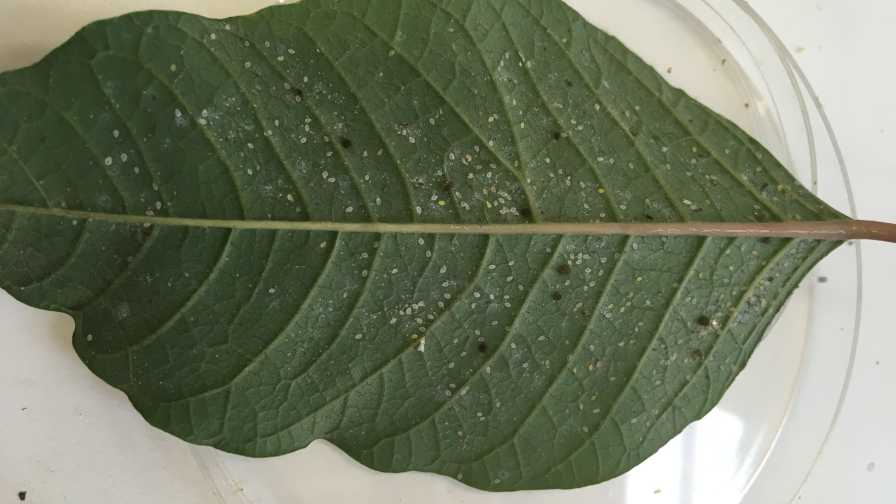The Benefits of Biocontrols in Poinsettias

High numbers of Bemisia whitefly nymphs and pupae were found in poinsettia crops relying on chemical control in 2018.
It’s poinsettia season again, and the question always comes down to this: Do I use chemicals to control Bemisia whitefly or do I switch to biocontrols in poinsettias?
This can be a complex decision for many growers, but here are some head-to-head comparisons from Ontario, Canada (North America’s third-largest floriculture production area) that show biocontrol is worth investing in.
Pesticides Vs. Bios: Efficacy
Because Bemisia whiteflies originate on cuttings, and all commercial producers currently rely on pesticides for management, your whitefly will be exposed to (and are potentially resistant to) several groups of chemicals before they even enter your greenhouse. These pesticide choices are rarely disclosed to the grower. Each year then becomes a game of Russian roulette when it comes to your choosing your whitefly pesticides, and losing can result in unacceptable whitefly pressure.
In a real-world example, a large Canadian producer had as much success with his compartments under chemical control in 2017 as he did with many of his compartments under biocontrol. This same grower wasn’t so lucky in 2018. Likely a result of high pesticide use on mother plants, all chemicals used by the grower failed –– even newer chemistries like the 4D class of insecticides. This resulted in significant crop losses, while no losses occurred in the bicontrol compartments. Other Ontario growers who relied on chemicals in 2018 faced extreme challenges to get their crop out; some resorted to dipping whole plants in insecticidal soaps out of desperation.
Although the U.S. generally has a greater number of chemistries at its disposal than Canada, the Mediterranean species of Bemisia (or “Q” type) –– one of two species of Bemisia common to poinsettia –– has an impressive ability to quickly develop resistance to all sorts of chemicals. Even the more common “B” type (or Middle East-Asia Minor species) can develop significant resistance.
Pesticides Vs. Bios: Economics
Cost is one thing growers are rightly concerned about when it comes to biocontrol. Depending on the company and products used, programs can range from a nominal 3 cents to around 12 cents per pot (based on the Canadian dollar; the U.S. cost would equate to between 2 cents and 9 cents). It takes a bit of playing to determine what works for your facility for the lowest costs, which is why it can be good to work with an independent consultant.
While it’s true that chemical control programs for whitefly in poinsettia are cheaper –– around 2 cents per pot in low whitefly pressure years –– this assumes the pesticides will work. In years when starting whitefly populations have developed significant pesticide resistance, costs can skyrocket as multiple (ineffective) sprays are made. The resulting pesticide costs, labor, and crop losses ultimately end up being more expensive than a biocontrol program would have been. And, as one grower put it, “Costs are irrelevant if you can’t control the pest.” Given its proven reliability, additional costs associated with biocontrol programs in poinsettia can be looked at as buying “insurance” for your crop.
Which Bios to Use
Switching to biocontrol can also be a little daunting. You have to decide which bios to use, the optimal rates, and when and how to apply them. Luckily, there are many knowledgeable consultants and company reps that can help. Generally, Ontario growers have success using one of three programs.
- Program 1: High rates (ca. 10/m2/week) of the parasitoids Encarsia formosa and Eretmocerus eremicus for 11 to 15 weeks. Both wasps parasitize and host feed on Bemisia whitefly nymphs. These come in handy combo emergence cards from many suppliers. Cards can go in as early as the misting bench – just cover with a Styrofoam cupto prevent moulding.
- Program 2: Low rates of Encarsia(0.25-2/m2 per week for nine weeks) plus the predatory beetle Delphastus (1-3/m2 total, in staggered releases). This method was pioneered by British Columbia’s Applied Bionomics and relies on fresh Encarsia that are purported to have better searching ability. Delphastus are added to help take care of any hot spots. Given its sensitivity to pesticide residues, Delphastus shouldn’t be applied until four weeks after cuttings are received.
- Program 3: The kitchen sink approach. This includes any of the parasitoids above to attack nymphs, plus Delphastus and miteslike Swirskii or Limonicus to attack whitefly eggs. Mites can be applied starting at misting (by broadcast) and given supplemental food such as pollen or Ephestia eggs to help increase their populations. On their own, mites aren’t enough to control whitefly.
One thing all these programs have in common is that they target multiple life stages of Bemisia. Biocontrol programs like this, coupled with tactics that help reduce incoming whitefly populations (such as dipping cuttings in soap and Beauveria-containing microbial pesticides), can set you on the path for a worry-free poinsettia season. Consider it a Christmas present to yourself.









